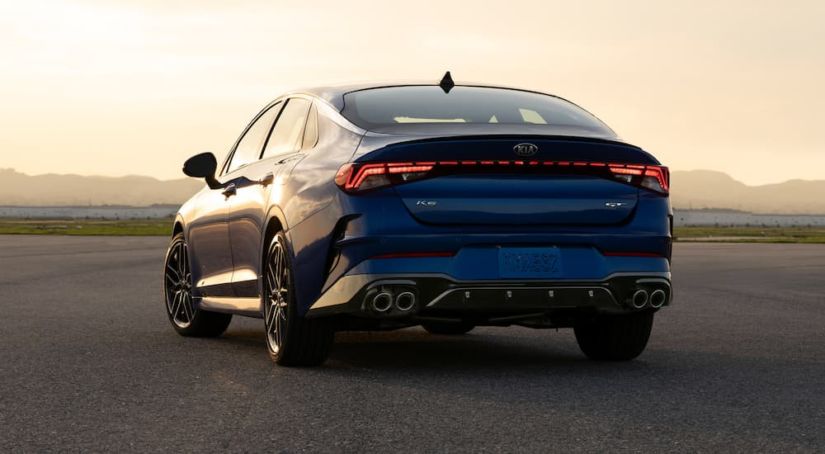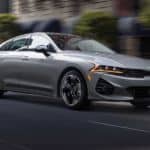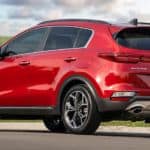The midsize sedan segment has been admittedly stagnant with the rise in popularity of crossovers. However, there’s still a lot to be said for the low cost and fuel efficiency of a sedan when a driver rarely needs the full capacity of an SUV. There are few cars that define the segment as well as the Toyota Camry, with a 3- year history of quality behind it. On the other hand, there’s no midsize sedan hotter than the Kia K5, an all-new model replacing the attractive and well-reputed Optima line. Let’s look at a 2021 Kia K5 vs 2021 Toyota Camry comparison to see how the hotshot newcomer measures up against the veteran nameplate.
Performance
We’ll focus on direct comparisons of the entry-level and performance/luxury trims. For the 2021 Kia K5, that’s the LX and GT (MSRP $23,490 and $30,490 respectively); on the 2021 Camry it’s LE, XSE, and TRD. As detailed pricing and features on the 2021 Camry are pending, we’ll look at the 2020 equivalents (starting $24,970, $35,130, and $31,170) with consideration to what we do know about 2021 at this time. The Kia has a clear edge on the price point; its top-trim GT is nearly $5,000 cheaper than the top Camry. While each of these trims is FWD-only, it’s worth noting that mid-level K5 trims and non-V6 Camrys have access to an AWD drivetrain for improved handling in poor weather conditions, a handy feature for those in wintry climates.
So let’s dig in. What makes these cars tick? For the Kia K5 LX it’s a 1.6L 4-cylinder turbocharged engine; that’s a 2.5L turbo on the GT. These engines produce 180 hp / 290 hp respectively and make 195 lb-ft / 311 lb-ft of torque. That 311 lb-ft is a best-in-class rating; to show off the power of the new model, Kia arranged a “Triple Threat Stunt” launching two cars past each other through the air while a third drifted underneath them. Attached to the engine is an 8-speed automatic transmission, available with “wet clutch” similar to designs used by Audi and Porsche. On top of that, the anticipated fuel efficiency is 29 MPG city / 38 MPG highway thanks to the small turbocharged engines.’
The current Camry drivetrains are powered by a 2.5L 4-cylinder block on the LE and a 3.5L V6 on the XSE V6 and TRD. These are muscley engines, delivering 203 hp / 301 hp, respectively, but the torque maxes out at 184 lb-ft / 267 lb-ft. Each also has an 8-speed automatic transmission. With intelligent fuel injection, valve management, and Prius-based efficiency-boosting. They achieve excellent fuel efficiency; the 2.5L is rated at 28 city/39 highway MPG, and the 3.5 L V6 gets 22 city/32 highway MPG.
The 8-speed transmissions will offer a smooth driving experience on both models. While there’s no doubting the greater power in the Camry, it achieves peak power at higher rpm than the K5. Higher torque, and at a low engine speed of 1500 rpm, should make the K5 a touch faster off the line. Both have excellent fuel efficiency; on the Kia, through the use of a small, inexpensive turbo engine, and on the Camry through intelligent design that comes for a price. One more thing – with a wide stance on the new N3 vehicle platform, the Kia K5 tracks 2” wider than the Camry, which should give it better cornering control in any head-to-head comparison.
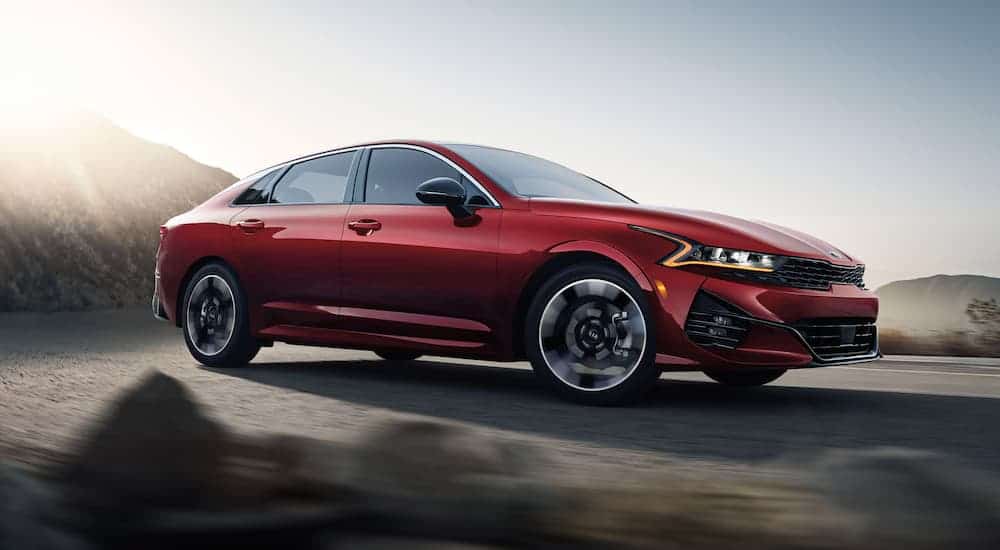
The Experience of the Car – Exterior and Interior Features
If we’re being honest though, you’re probably not looking to take your midsize sedan to the races. No, you’re probably more concerned with how comfortable, well-equipped, and intuitive the cabin is and how the car looks when you’re walking up to it. Lucky for you, these are two very attractive midsize sedans. Aggressive sculpting of the front end makes the Camry interesting at worst and downright intimidating in the TRD outfit. On the other hand, the K5’s wide shark-skin grill, unique lighting designs, and fastback silhouette lend it a unique appearance for all trim levels, looking a lot more expensive than it really is.
Top trims of both models offer black and chrome exterior accents like badging, handles, and side mirrors, and both have skylight features. The K5’s panoramic sunroof is bigger than the Camry’s moonroof, but the Camry XSE V6, for example, does offer a panoramic glass roof of its own. The glass and windshields on both models are specially designed to reduce noise and disperse solar energy to maximize interior comfort. One departure between the two models is fog lights – these come standard on top-trim K5s, but we don’t see the option even on the Camry XSE.
The interior of both sedans is nicely laid-out.
The centerpiece of the Camry is the center console, featuring a floating 7” or 9” multimedia touch screen above a striking character line that sweeps from the instrument cluster to the passenger side. The story is the same in the Kia. The center console is angled for a better view of the larger 8” / 10.25” touchscreen that extends naturally from the instrument cluster. Nice material selections and classy styling give both models an uncompromising air, while modern compatibilities such as Apple CarPlay, Android Auto, and wireless charging keep all drivers connected.
There’s an interesting trade-off between K5 and Camry when it comes to seating. While the entry-level K5 LX has a 6-way manual adjustment, the Camry LE has an 8-way power adjustment and lumbar support for the driver. The only change on top trims like the XSE V6 is the addition of heating and an 8-way power adjustment for the passenger as well. The K5 GT, on the other hand, provides 10-way adjustment and heating, but only for the driver. At high trim, we think it’s a matter of personal preference. The Camry has a little more to offer in the shotgun seat, but the K5 caters better to the driver.
The auditory experience of a sedan is not to be neglected either. The K5’s available 12-speaker Bose system offers a touch more quality than the Camry’s 9-speaker JBL with a subwoofer. On top of this, the K5’s audio system comes with “Sounds of Nature” preloaded ambiance tracks for a more relaxing driving experience. Completing the interior comfort package is dual-zone automatic climate control, available standard on all K5s but only as an option on entry-level Camry LEs.
Safety
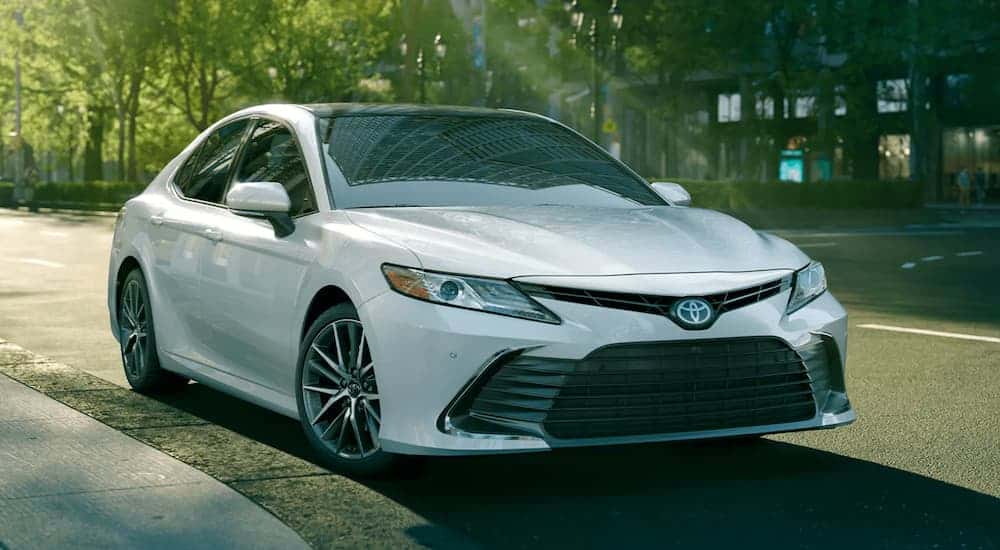
The most important thing inside every car is the driver, although many drivers would probably say it’s actually their passengers. We completely agree on both counts, which is why a comprehensive suite of safety technologies is so critical in a purchasing decision. The K5 matches Toyota’s Star Safety and Safety Sense packages, which include technology such as ABS, traction control, pre-collision warning, lane departure alert, and automatic high beams. Both vehicles offer top-notch pedestrian detection with improved-for-2021 low light function, and an assist to apply the brakes when making a left turn under certain conditions when a pedestrian is detected. Emergency locking seatbelts, hill start assist, automatic engine shut off, rear occupant alert, a rear-view camera, and an available blind spot monitor with rear cross-traffic alert features are all common between the 2021 K5 and 2021 Camry.
The two models offer sophisticated cruise control systems. Camry’s dynamic cruise control changes speed to maintain a safe following distance, with the intelligence to accelerate when passing for easier overtaking. The Kia K5’s adaptive cruise control explicitly highlights its stop-and-go functionality and proudly integrates Highway Driving Assist functions. This programming works with downloaded navigation data to automatically slow down for upcoming exits or curves, if safe to do so.
Finally, there’s a couple of disparate features worth pointing out. The Camry offers a front-mounted camera for reading and displaying road sign information on the dashboard so you won’t miss critical updates while keeping your eyes on the road. The Camry also notes the inclusion of whiplash-injury-lessening seats; the K5 does not mention this. The K5, on the other hand, offers driver attention warnings to detect and caution against distracted driving. This is provided alongside a leading vehicle departure alert, so you’ll never be the person holding everyone up at a green light. Finally, the K5 includes Safe Exit Assist. This feature produces an alarm and, if necessary, locks the doors of the car when parked to prevent opening them if dangerous oncoming traffic is detected.
The Wrap-Up
The Toyota Camry has a 37 year pedigree of excellence in the midsize sedan segment, and 2021 sees it offered with more options than ever. However, we think the all-new 2021 Kia K5 is going to make quite a splash as it replaces the venerable Optima. With similar fuel economy and best-in-class torque at a lower MSRP, we like the performance of the K5. It looks amazing inside and out, and its larger, angled multimedia touch screen makes it easier to see and use. Standard dual-zone climate control offers better passenger comfort at entry-level, and 10-way adjustable seating for the driver makes the K5 GT a better “driver’s car” than the Camry TRD. Finally, the K5 sacrifices nothing for safety, with an advanced cruise control and features to combat distracted driving and exiting, which set it apart from the Camry as well.
A new car is a huge decision, and midsize sedan owners need to get the most for their money. There are no bad choices between the 2021 Kia K5 and 2021 Toyota Camry, but we think the K5 has an edge in most categories. Plus, there’s real truth behind the slogan Kia used to backdrop the K5 “Triple Threat Stunt” – “boring doesn’t fly around here.”
